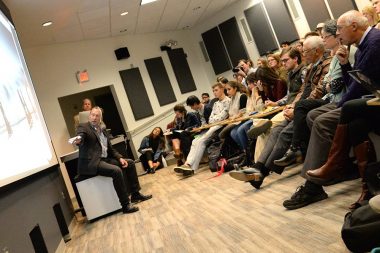As part of his Oct. 25 on-campus lecture, The New York Times Magazine contributing reporter outlined his expansive, 42,000-word article on the Middle East, detailing the nearly two years he spent developing a storyline involving six main characters.
During the reporting process of “Fractured Lands: How the Arab World Camp Apart,” his book-length article published in its entirety in the Aug. 14, 2016, New York Times Magazine, journalist Scott Anderson relied heavily on his “fixers” – hired guides and translators – while traversing war-torn regions of the Middle East.

If he needed access to a secret prison holding captured ISIS fighters, his fixer secured it. If his interview at a Libyan restaurant ran long – 25 minutes was the limit – it was time to move, for there was “a bounty on your head,” Anderson explained.
“You’re a walking around pot of gold,” the reporter added. He explained that, because European nations will pay ransoms to free kidnapped nationals, European journalists are worth millions. Because the U.S. government refuses to pay, Americans are seen more bluntly as trophies who can be publicized and killed.
Anderson’s fixers provided safety and entry, often when getting permission didn’t seem like an option. “All rules can be skirted, if you get to the right person,” he said.
Elon, through its School of Communications, is an active member of the Campus Consortium of the nonprofit Pulitzer Center on Crisis Reporting. The school and the Pulitzer Center co-sponsored Anderson’s visit to Elon, which included a lecture – photos available here – a few classroom visits, dinner with students in living-and-learning communities, and meetings with participants in Elon’s student media organizations.
Following an introduction from Associate Professor Glenn Scott, Anderson used his lecture to walk the McEwen audience – largely communications students – through his reporting process and the trials and tribulations he incurred while compiling content for The New York Times Magazine’s longest piece ever written. The 42,000-word article intertwines the lives of six individuals across the Middle East who lived through autocratic rule, the turmoil of the Arab Spring and the rise of ISIS.
From a female activist in Egypt to a Syrian refugee in Germany, these individuals illustrate the human side of the collapse of regimes and the rise of terror and uncertainty across the region. In the talk, as in his article, Anderson provided a sense of how it all unfolded through the eyes of six characters who either lived in or fled Egypt, Libya, Syria, Iraq and Iraqi Kurdistan.

“Fractured Lands” represented a collaborative effort between The New York Times and the Pulitzer Center on Crisis Reporting, which both agreed to support Anderson in a bid to produce an in-depth and influential report to explain how people have coped in the chaotic situations in the Middle East and Northern Africa.
“We wanted to build a piece on the modern Middle East,” Anderson said. “With the barrage of daily news … it can all blend together and be hard to keep it all straight.”
To create an all-encompassing piece, connecting events from around the Middle East, Anderson sought out human-interest stories. Identifying the article’s six sources became almost a “treasure hunt,” he said, engaging and vetting hundreds of people, which was no small task considering his limitations.
The most difficult obstacle, he said, was likely locating a person who could provide a Syrian perspective. Due to safety concerns, The New York Times doesn’t allow journalists to travel to the country’s rebel-held regions. And he couldn’t secure a visa to move inside the country anyway.
While all six characters provided compelling first-person accounts, such as Khulood al-Zaidi, a women’s rights activist who had to flee for her life, likely the most chilling perspective came from Wakaz Hassan, a captured ISIS fighter.
Now imprisoned in a secret jail operated by the Kurdistan Regional Government, Hassan spoke openly with Anderson about his ISIS participation, his thought process and his actions, including his involvement in executions. He went so far as to act them out for the reporter. He went “into detail of how you shoot someone in the head,” Anderson said. It was Hassan’s forthcoming nature that made him stand out from other ISIS prisoners he interviewed. Others often deflected their own involvement.
While the paths, plights and actions varied wildly for the six main characters of “Fractured Lands,” Anderson was drawn to each because of their honesty and openness.
“We wanted to tell the story of people,” he said, “and build a tapestry of what was happening in this region.”


